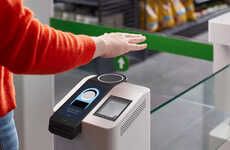
The Quixter Vein Scanner Reads the Unique Patterns on Your Palm
Laura McQuarrie — April 22, 2014 — Unique
References: quixter.se & luxuo
Although "vein scanning" might sound pretty intimidating, biometric identification systems are becoming more widely accepted as secure and alternative ways to pay. This vein scanner was developed by Fredrik Leifland, a student of Sweden's Lund University and now, the founder of Quixter.
There doesn't seem to be a name for Quixter's vein scanner just yet, but it could probably use one, since the payment system is completely non-invasive and only scans the unique vein patterns on the palm of your hand and has nothing to do with the veins on your insides.
The scanner still requires users to enter the last four digits in their phone number before scanning, but overall, the system seems like a much simpler way to pay. So far, the payment system has been introduced at 15 different locations on the Lund University campus, available for use by thousands of students.
There doesn't seem to be a name for Quixter's vein scanner just yet, but it could probably use one, since the payment system is completely non-invasive and only scans the unique vein patterns on the palm of your hand and has nothing to do with the veins on your insides.
The scanner still requires users to enter the last four digits in their phone number before scanning, but overall, the system seems like a much simpler way to pay. So far, the payment system has been introduced at 15 different locations on the Lund University campus, available for use by thousands of students.
Trend Themes
1. Biometric Payment Systems - The increasing adoption of non-traditional, biometric identification payment systems offers disruptive innovation opportunities for the payment processing industry.
2. Non-invasive Recognition Technology - Advances in non-invasive recognition technology present opportunities for the development of innovative, secure payment systems to disrupt the financial services industry.
3. Campus Payment Systems - Developing and promoting payment systems on college and university campuses can provide beneficial opportunities for both students and the payment processing industry.
Industry Implications
1. Payment Processing - The payment processing industry has disruptive innovation opportunities through the development of biometric identification payment systems and non-invasive recognition technology.
2. Financial Services - Innovative, secure payment systems that utilize biometric identification and non-invasive recognition technology can present valuable disruptive innovation opportunities for the financial services industry.
3. Higher Education - Higher education institutions have an opportunity to promote efficient and secure payment processing solutions among their students by developing and offering innovative payment systems on campus.
5.2
Score
Popularity
Activity
Freshness















